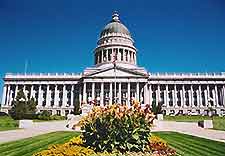Salt Lake City History Facts and Timeline
(Salt Lake City, Utah - UT, USA)

Salt Lake City, the capital of Utah, is best known nowadays as the headquarters of the Mormon Church (the Church of Jesus Christ of Latter-day Saints). In fact, the city's origins date back to the 1847 arrival of Brigham Young and his band of persecuted Mormon followers.
History shows that the Salt Lake Valley was inhabited for thousands of years before the Mormon arrival, with indigenous tribes having seasonally occupied the area.
Early Settlements
Brigham Young is believed to have had a vision of the Salt Lake Valley before visiting the area. On arriving in the valley, he is reported to have said, 'This is the right place, drive on.' His quote has gone down in Salt Lake City history and is now remembered by the 'This is the Place Heritage Park', which overlooks the spot where he reportedly made the statement.
Temple Square
Temple Square is the most-visited site in the whole of Utah. It hosts the headquarters of the Latter-day Saints (LDS) Church and the Salt Lake Temple, where non-Mormons are forbidden from entering. Brigham Young is said to have identified the site for the temple after only four days in the Salt Lake Valley. The temple took some 40 years to construct, from 1853 to 1893, and is now considered to be the focal point of the entire city. Non-Mormons can learn more about the religion by visiting the Church History Museum, near Temple Square.
Conflict with the Government
Salt Lake City went on to attract large numbers of Mormon settlers during the 1850s, as well as gold-seekers. These early days were not without conflict however, since the federal government exhibited a certain anti-Mormon stance, especially where polygamy was concerned. In 1857, President James Buchanan ordered Brigham Young to stand down as governor of Salt Lake City. Young refused and this led to the start of the Utah War (1857 to 1858). Many LDS church leaders were imprisoned during this time, leading the Mormons to abandon polygamy by 1890. The city was then named the state capital in 1896.
Ethnic Diversification of the City
Up until 1869, Salt Lake City had been almost exclusively Mormon. However, the completion of the First Transcontinental Railroad in the same year meant that other ethnic groups, such as the Chinese and the Japanese, built their own significant communities.
Missionaries from other European churches, such as the Catholic Church and the Greek Orthodox Church, also built their own places of worship. As a consequence, present-day Salt Lake City is actually less than 50 percent Mormon. The Chinese have long gone, with their community being demolished in 1952. Their place in Salt Lake City history is now remembered by a historical marker. Similarly, the Japanese left behind a Christian chapel and a Buddhist temple in the city center.
Winter Olympics
Salt Lake City made several attempts to secure the Winter Olympics, starting as far back as 1930. However, it wasn't until 1995 that it was successful in securing the 2002 Winter Olympics. Despite a number of corruption and drug scandals that marred the Games, it was seen as one of the greatest successes in the history of Salt Lake City.
Hosting the Games allowed the city to markedly improve its infrastructure, while the Olympic venues continue to be used to this day for a variety of events. The Games are remembered by an exhibition on the fourth floor of the Salt Lake City and County Building, a lavish construction that has been home to the city's government since 1894.
 Salt Lake City, the capital of Utah, is best known nowadays as the headquarters of the Mormon Church (the Church of Jesus Christ of Latter-day Saints). In fact, the city's origins date back to the 1847 arrival of Brigham Young and his band of persecuted Mormon followers.
Salt Lake City, the capital of Utah, is best known nowadays as the headquarters of the Mormon Church (the Church of Jesus Christ of Latter-day Saints). In fact, the city's origins date back to the 1847 arrival of Brigham Young and his band of persecuted Mormon followers.